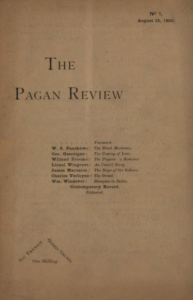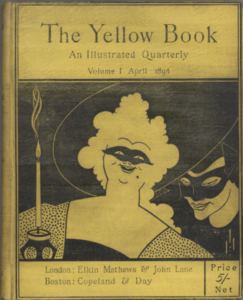Spirituality and Paganism in “Tree Worship” by Richard Le Gallienne
© Copyright 2022 Emma Milivojevic, Toronto Metropolitan University
Introduction
Richard Le Gallienne’s Tree Worship is an ode to the uprising of questioning the predominant Protestant religion in the 1890s and poses a realistic view of this crisis within shifting from a prevalent religion such as Puritanism into something more self-fulfilling. “Tree Worship” was published in the first edition of The Yellow Book in April of 1894 and is composed of eighteen quatrains in alternative rhyme. This poem was Le Gallienne’s first work in The Yellow Book, in which he would go on to partake in all four volumes.
The shift from Puritan beliefs to Paganism and Occultism was a major cultural shift that changed the views of society in the late 1800s. By looking through an aesthetic and Pagan lens, there are many reasons why so many people ran away from Puritan beliefs that were widely worshiped in English society at the time. The sense of urgency and desperation questions the core of Puritan beliefs and asks why so many people were beginning to turn away from them. Le Gallienne’s “Tree Worship” highlights the raw and unfiltered nature of morality and consciousness within a belief by providing insight into the mind of a person who is partaking in this religious shift.
The Puritans and the shift to Occultism and Paganism in Literature
The Puritans were a theocratic society that preached the word of god and wanted authorities to enforce religion in society. (Baracskay, 2009) Of course, many people did not feel comfortable in the shackles of such a society, and the need to conform and comply is what drove many people away from this belief. Thus, people began looking towards something like Paganism which had no bounds and was open to anyone. On top of being a fluid belief, many enjoyed Paganism and worshipping nature for its aesthetic value. Viewing the world as something of beauty and art made it easier to live life, and not be forced to conform to something that many people did not believe in, in the first place.
The story begins with a detailed recollection and description of the glorious tree that a man stumbles upon. Le Gallienne describes the tree as something godly and notes how every other religion has failed him. The tree becomes a major facet of his life, and he embraces the tree as a facet of God himself. The basis of this story is rooted in scarcity and fear, and with this became the Decadence era which caused a great uproar in the question of everyday existence (Chadwick, 2010) and the connections between religion and sadomasochism, as well as the practice of self-purification and the seeking of mystical experiences. (Oscar Wilde Society, 2010) This coherent ideology explains why people were seeking an exit from Puritan beliefs and looking for explanations elsewhere. Tree Worship is a metaphor for not conforming to Puritan ideologies, and God can be found within ourselves or within anything that brings us beauty and comfort.
Le Gallienne says “His eighteenth-century flesh hath fattened nineteenth-century cows” (The Yellow Book, p.g. 59, 1894) and this passage illustrates the idea that beauty and nature can feed the hole of comfort from religious beliefs that Puritan beliefs could not, beliefs that were pushed upon English society since birth. This story is more fantastical than realistic, but the Decadent ideology remains in place. Many believed that literature and art fulfilled many ethical roles (Burdett, 2014), and in the case of “Tree Worship” became almost a replacement for religion. The comparison between religion and decadence also comes into play, and the idea of escape is expressed in “Tree Worship” as the decadent spirit is all about escapism from a reality that is too unbearable to be part of. (Murray, 2012) The height of Decadence pushed the ideas that “Tree Worship” expands on, and how through looking away from Puritan beliefs, morals can be expressed elsewhere. Le Gallienne says “I seek God old tree; accept my worship, thou!” (The Yellow Book, 1894) – by critically looking through the lens of denying Puritan ideologies, we can expand on why decadence was an escape from reality, and why people were looking towards it for moral and personal fulfillment. Many believed that literature and art fulfilled many ethical roles and in the case of Tree Worship became almost a replacement for religion. This opens the door to Paganism and Occultism. As the pagan revival began, journals like The Pagan Review began to be published and highlighted aesthetic and mystical ideas that did not conform to the majority puritan society of the time. Tree Worship though was included in The Yellow Book which was predominantly composed of controversial content as The Pagan Review was.


Tree Worship as an Aesthetic Practice
Tree Worship portrays the feeling of not resonating with a Puritan society, and giving up on these ideologies and turning to decadent ideologies instead. The story portrays the working transition from a Puritan ideology to a decadent one through the lenses of Puritan denial and the future of culture. Paganism is often referred to as an umbrella term for many different forms of worshiping nature and Tree Worship falls into the category of this practice. Paganism can be seen through an aesthetic lens as it defies the modern and puritan way of living life and exploring moral boundaries. It highlights and explains how aesthetically, paganism is a belief that explores beauty and art and escapes conventional boundaries. Scholarly enchantment is an aesthetic practice in which one finds meaning in an unconventional phenomenon and transforms it into a meaningful one. (Winick, 2018) The tree in this story represents meaning and morality in its most natural form and looks at religion as a practice of beauty and art versus a conforming belief that is predominant in society. Escapism is another aspect of this aesthetic belief. The idea of esthetics, art, and beauty took over in the late 19th century to answer this idea of looking elsewhere for God. This story supports the idea of decadent paganism as a fulfillment of moral and fundamental ideologies of life through art and literature. As well as the idea of how the transition from one society to another occurred, and at times drove people to mysticism over religion.
Occultism and Paganism dwell between two categories, being esoteric and exoteric forms of religion. (Winick, 2018) Esoteric religion is one in which there is an innate sense of secrecy and experiences that are passed on between people who have experiences instances of self-fulfillment and becoming one with the divine. (Winick, 2018) Tree Worship falls into the esoteric category and highlights a step away from exotericism which Puritanism belongs in. Exoteric religion deals with public dimensions of a religion such as a church, group worship and more accepted practices. (Winick, 2018) Esoteric beliefs are ones that are aesthetic and step away from conventional Christian practices. The step towards esoteric beliefs began when the Pagan revival began through the decadence era, and Le Gallienne’s story portrays the separation between esoteric and exoteric beliefs. The decline of Puritanism opened the door to self-fulfillment along with a major culture shift into Paganism and Occultism. Throughout the story, Le Gallienne proposes the idea to search for fulfillment in nature and describes the mystical tree as he would a person and refers to it as a womanly figure in much of the poem. The aesthetic purpose of the tree is introduced when Le Gallienne describes many sitting under that tree before him, and how the tree’s wisdom is passed on through generations. Ideas like this are included in many sects of Paganism as well, obtaining wisdom from nature as you would from God.
Le Gallienne’s Controversy
Le Gallienne’s ideas of worshiping a tree are somewhat controversial, as he goes on to talk about all other gods failing him. This is something he knew would enrage the Puritans. Le Galienne’s life was a bit tragic, and his outdated ideas of the romance of love and also women (which is seen in Tree Worship as he describes the tree as he would a woman) ultimately caused him to be unsuccessful in America as a writer. His ideas around can be seen throughout the poem as he continues on to describe the tree as a womanly force. This was another controversy of its own, as at the time women were undermined and rarely seen as a powerful and godly force.
Le Gallienne calls the tree “god’s best angel of spring” which can be seen through the aesthetic lens as looking to nature and art as a form of moral fulfillment. This line once again portrays the idea of esoteric beliefs versus exoteric beliefs. This approach is important to look at because no one was really questioning the puritan faith before this movement, those who believed in the aesthetic ideology were seen as macabre and unusual, and Le Gallienne’s work gives us insight into the crisis by looking away from a religion that everyone else looks up to.

The 1890s were a time of rapid change and development. The new normal was questioning everything in society and culture. Richard Le Gallienne’s Tree Worship perfectly encapsulates the uprising of Occultism, Paganism and spirituality by providing a close-up experience of what many of the time were feeling and questioning. Aestheticism opened the door for many beliefs aside from Puritanism and Christianity to be experienced and questioned. As an ode to a new way of experiencing life, one of art and one of beauty, Tree Worship is a story that allowed many to feel heard and seen throughout their struggle with faith and belief. Le Gallienne made those people feel seen and heard, and that is why his works are so important to modern-day Paganism and Occultism.
Works Cited
Baracskay, Daniel. Puritans, 2009, https://www.mtsu.edu/first-amendment/article/1372/puritans#:~:text=Many%20colonists%20came%20to%20America,were%20hostile%20to%20the%20Puritans.
Bodley Heads. No. I: Mr. Richard Le Gallienne
Beardsley, Aubrey, and Henry Harland. The Yellow Book: An Illustrated Quarterly. Elkin Mathews & John Lane, 1894.
CHADWICK, PETER. “Decadence and Spirituality in Late Nineteenth Century Artists and Writers.” The Wildean, no. 37, 2010, pp. 93–102. JSTOR, http://www.jstor.org/stable/45270179.
Goldfarb, Russell M. “Late Victorian Decadence.” The Journal of Aesthetics and Art Criticism, vol. 20, no. 4, 1962, pp. 369–73. JSTOR, https://doi.org/10.2307/427899.
KING, FREDERICK D. “The Decadent Archive and the Long History of New Media.” Victorian Periodicals Review, vol. 49, no. 4, 2016, pp. 643–63. JSTOR, http://www.jstor.org/stable/26166581.
“Legallienne_bio – Yellow Nineties 2.0.” Yellow Nineties 20, https://1890s.ca/legallienne_bio/.
MIELE, FRANK J. J. The American Civil Religion In The 1890s: In Crisis And Revival, Tulane University, Ann Arbor, 1984.
Maillet, Chloé. (2017) Un orgasme dans les vers et la gangrène ?. Terrain (translated to English)
Sonnex, Charmaine, et al. “Flow, Liminality, and Eudaimonia: Pagan Ritual Practice as a Gateway to a Life with Meaning.” Journal of Humanistic Psychology, vol. 62, no. 2, 2020, pp. 233–256., https://doi.org/10.1177/0022167820927577.
Sharp, William, The Pagan Review, 1892. Yellow Nineties 2.0
Sharp, William. The Pagan Review. 1905.
Images in this online exhibit are either in the public domain or being used under fair dealing for the purpose of research and are provided solely for the purposes of research, private study, or education
